Recent Articles
Popular Makes
Body Types
2021 Hyundai Venue vs. 2021 Nissan Kicks
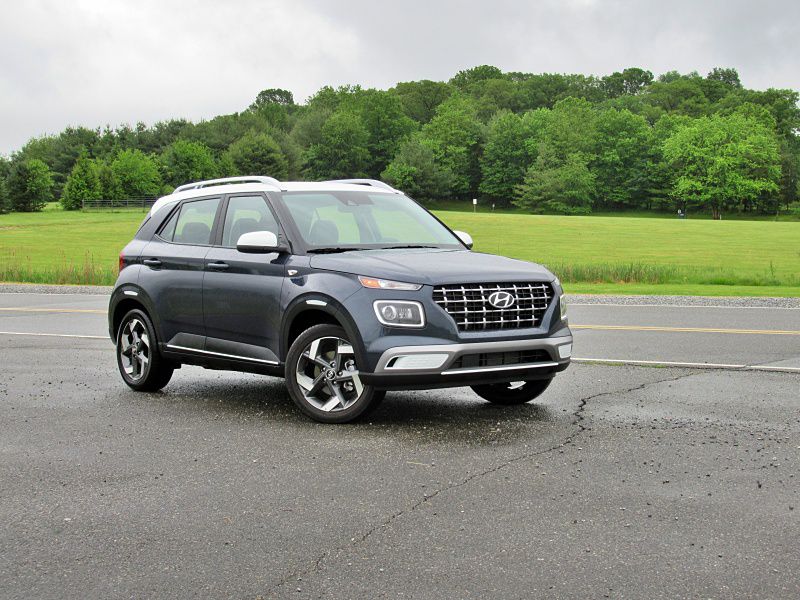
2021 Hyundai Venue Denim ・ Photo by Brady Holt
SUVs have a lot of advantages. For many people, it’s important that they’re big, rugged, and tough-looking, with go-anywhere all-wheel drive and the ability to tow a trailer. Other folks might just want something with more cargo space and a higher seating position than a sedan.
If you’re the latter type, the 2021 Hyundai Venue and 2021 Nissan Kicks could be right up your alley. These are subcompact crossovers with tiny engines, no option for AWD, no towing capacity — and extra-low prices. Fuel-efficient and easy to park, the Venue and Kicks are essentially tall, boxy hatchbacks. We tested both vehicles so we could compare them across eight categories and then name an overall winner. Keep reading to see if these vehicles could be a budget-friendly solution to your SUV needs, and which one could be the best for you.
Pricing and Features
Both the Venue and the Kicks are among the least expensive SUVs (or SUV-like cars) you can buy today. The Kicks starts at just $19,550, while the Venue costs even less: $18,750. Both are decently equipped even on their base forms, with lots of standard safety and infotainment features.
The Kicks has more standard features than the Venue, including blind-spot monitoring and a six-speaker stereo instead of a four-speaker one. However, you get those features — along with automatic climate control and 17-inch alloy wheels — by stepping up to the Venue SEL for $19,800. Hyundai also makes up that $250 difference over time by providing three years of free scheduled maintenance and a longer warranty. The Kicks does have some options that aren’t available on the Venue, including full leatherette upholstery, adaptive cruise control, a Wi-Fi hotspot, a premium sound system, and a heated steering wheel. But for such value-focused vehicles, the Venue’s lower pricing takes this category.

Photo by Brady Holt
Exterior Design
The Kicks and Venue are both subcompact vehicles, among the smallest you can buy anywhere. But at 169 inches long (14 inches less than a Nissan Rogue), the already-tiny Kicks is 10 inches longer than the still-tinier Venue.
Given the two crossovers’ similar heights, that leaves the Venue looking boxier and stubbier than the Kicks. Hyundai decided to play that up with rectangular headlights, taillights, and grille, and an upright front end. Nissan made the Kicks curvier and more aggressive, particularly after a fresh update this year. Its headlights are like spears alongside a big grille that dips to the ground. And the rear leans forward cheekily, accentuated by an upward kick in the windowline. In a welcome update this year, alloy wheels are now standard equipment on all Venues; even more significantly, all but the base SE get last year’s hard-to-find 17-inchers. The tiny 15-inch wheels found on most 2020 Venues looked lost in the car’s big wheel wells. (The Kicks comes standard with 16-inch steel wheels on the base S and 17-inch alloys on other models.) Wheels aside, some people will prefer the more dynamic Kicks and others the simpler Venue, so we’ll leave this category as a tie.
Tie
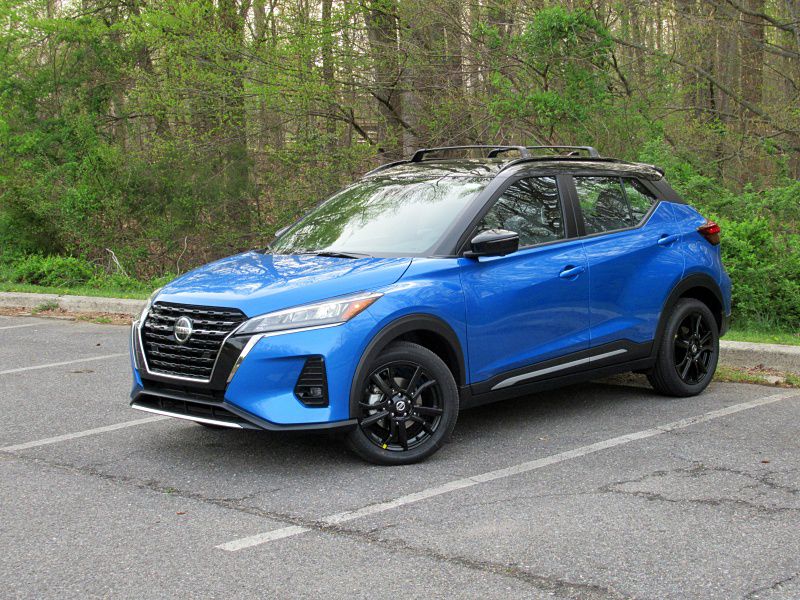
Photo by Brady Holt
Interior Design
The Kicks debuted as a 2018 model and the Venue followed just two years later, but to us, the Hyundai feels a generation newer than the Nissan inside. The Venue’s simpler lines and well-chosen colors are contemporary without being aggressively modern, while the Kicks’s dashboard strikes us as a busier, less cohesive design.
Still, both cabins offer easy-to-use controls, and the already-basic Kicks has more soft-touch interior plastics than the even more budget-grade Venue. The Venue has a crisply rendered 8-inch infotainment screen even on the base Venue SE. The base Kicks S has a 7-inch screen, though the upper-trim SV and SR now upgrade to 8 inches as part of this year’s update. Nissan also added Android Auto and Apple CarPlay to the S after previously reserving it for upper models. If you’re getting an upper-trim Kicks anyway, its slightly richer cabin materials might tip the scale the other way, especially if you disagree with us about which interior looks fresher. But we’re going to award this category to Hyundai for its bigger standard infotainment screen.
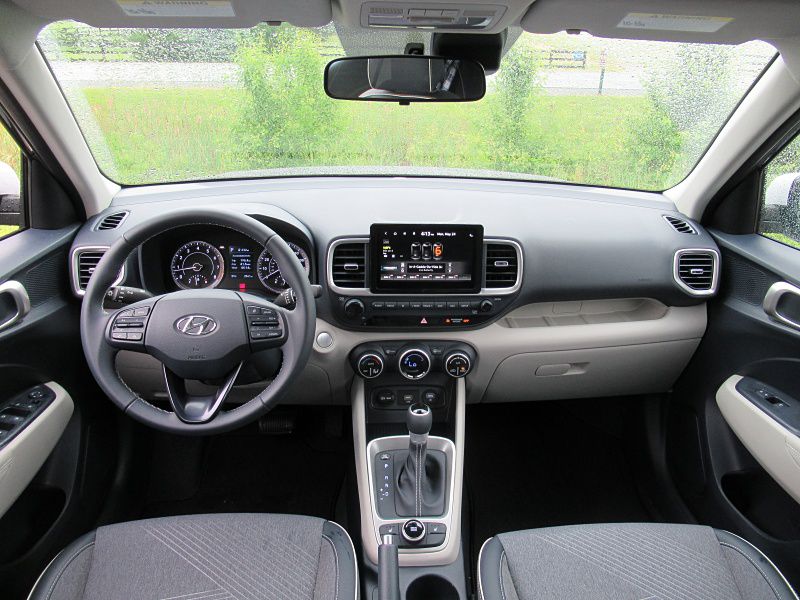
Photo by Brady Holt
Interior Comfort
Inside, the Kicks and Venue are both more accommodating than you might expect for such small vehicles. They have well-shaped, comfortable front seats and plenty of space, though two big people in the front seats would be competing for the narrow center armrest. That feature is a new addition to the 2021 Kicks, by the way, and it’s a welcome change; Nissan also upgraded the old Kicks’s tiny cupholders.
The main difference is in the backseat, where the Kicks’s extra 10 inches of length pay off. Two adults can fit on a well-shaped, supportive cushion in the rear of the Nissan. The Venue has tight knee clearance unless the front seats are well forward. In another downside, unless you get the top Denim trim level, the Venue has hard plastic armrests on the doors; the Kicks provides a more comfortable padded surface.
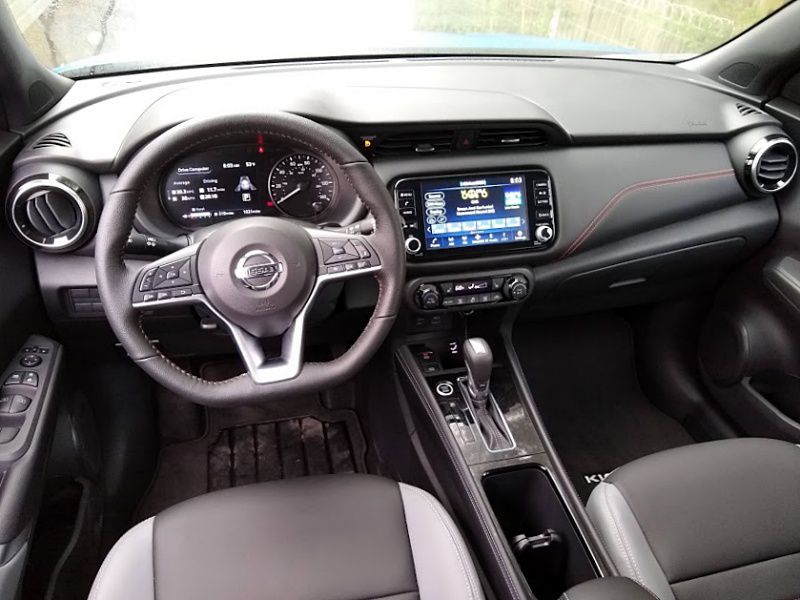
Photo by Brady Holt
Cargo and Utility
The Venue has a modest 18.7 cubic feet behind its rear seat. That’s more volume than a sedan’s trunk, but standing upright with relatively little space on the floor. You can fold down the rear seat to create a boxy cargo hold, which makes the Venue much more useful than a sedan for times you need to carry lots of stuff but not passengers. A useful adjustable-height cargo floor can be lowered for maximum capacity or raised to create a flush cargo floor with the folded seatbacks.
The bigger Kicks, unsurprisingly, has more cargo space. It’s a far more generous 25.3 cubic feet behind the rear seat, though the boxy Venue nips at its heels for 32.3 cubic feet in total quoted capacity. (You gain more than 7 cubic feet by folding down the rear seat, to be clear; Nissan just measures the two volumes differently.) It doesn’t have an adjustable cargo floor, but the extra space is even handier.
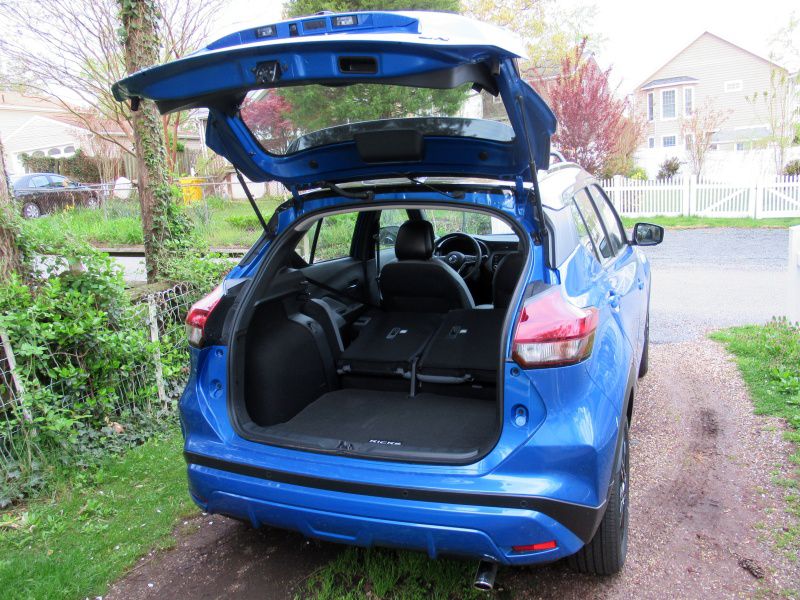
Photo by Brady Holt
Driving Experience
The Kicks’s tiny 1.6-liter 122-horsepower four-cylinder engine is smaller than any other SUV-like vehicle in the U.S. — except the Venue, whose 1.6-liter has 121 horsepower. Still, both vehicles are peppy at low speeds and plenty capable of cruising with freeway traffic. It’s just the intermediate step that gives them trouble: accelerating from low speeds to higher ones. Their engines can roar loudly when you urge them to go, yet their maximum thrust is limited. Still, over the years, we’ve spent five weeks in different Venue and Kicks vehicles and rarely needed to push the engines too hard.
Both little crossovers are agile at low speeds and easy to park. The Kicks has an excellent 34.1-foot turning circle, and the Venue’s is even better at just 33.4 feet. The Nissan has a smoother ride on the highway, while the Hyundai’s controls — the throttle, brake, and steering — felt smoother to us than the Kicks’s. Since we think of these as city-friendly vehicles, we’ll give the edge to the Venue for its better low-speed behavior; if you’ll spend a lot of time on the highway, though, you might pick the slightly more solid-feeling Kicks.
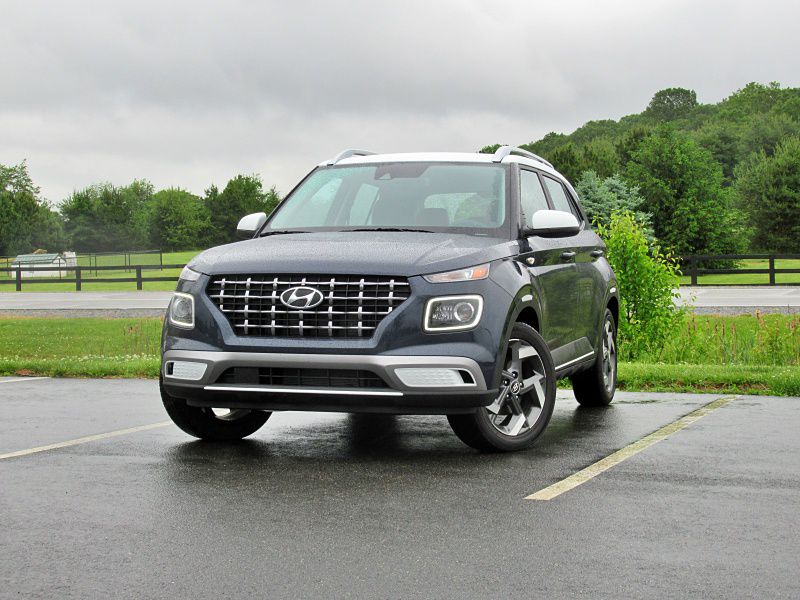
Photo by Brady Holt
Fuel Economy
Since they’re not much like SUVs in many other ways, it’s not too surprising that the Venue and Kicks use less gasoline than typical SUVs, too.
The Venue has an EPA-estimated 30 mpg in the city, 33 mpg on the highway, and 31 mpg combined with its only available powertrain: the 1.6-liter engine, front-wheel drive, and a continuously variable automatic transmission, known as a CVT. (Last year’s Venue also offered a six-speed manual, which is no longer available.) The Kicks — also sold only with a 1.6-liter engine, front-wheel drive, and a CVT — does even better in EPA testing: 31 mpg in the city, 36 mpg on the highway, and 33 mpg combined. Aside from hybrids and electric vehicles, the Kicks is the EPA’s most efficient SUV on sale today. However, we’re going to call this category a tie because the EPA ratings don’t match our experience. We’ve tested three Kicks vehicles that each averaged 33 mpg to 35 mpg, and two Venues that saw 37 mpg and 41 mpg. We don’t do scientifically repeatable testing like the EPA, but that difference is consistent enough for us to take notice.
Tie
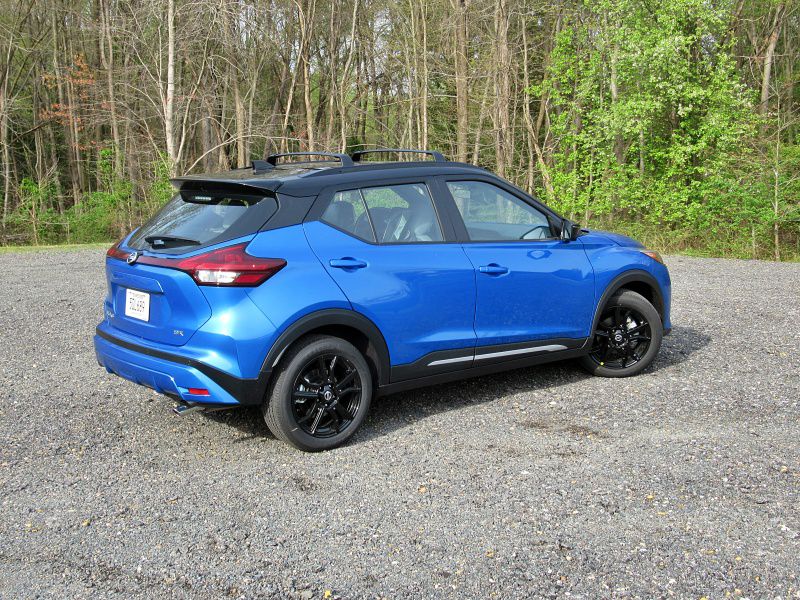
Photo by Brady Holt
Safety
The Venue earned the Insurance Institute for Highway Safety’s Top Safety Pick designation for its crash-test and accident-avoidance performance, and four out of five stars in National Highway Traffic Safety Administration crash tests. The Kicks had similar performance, but the IIHS hasn’t fully tested the vehicle, and its four-star NHTSA score includes a disappointing three stars for passenger protection in frontal impacts.
Both the Venue and the Kicks come packed with standard safety features that cost extra even on many luxury cars, including automatic emergency braking with pedestrian detection. The Venue also provides forward automatic lane-keeping steering corrections while the Kicks only gives an alert, and it has standard driver monitoring that costs extra on the Kicks. But Nissan counters with blind-spot monitoring (added only to the Venue SEL and Denim models) and rear parking sensors with rear automatic braking (unavailable on any Venue). The Kicks also offers adaptive cruise control and a surround-view parking camera, which aren’t available on the Venue. The Kicks’s feature list is a bit more impressive, but we’ll choose this winner based on the Venue’s greater proven crash protection.
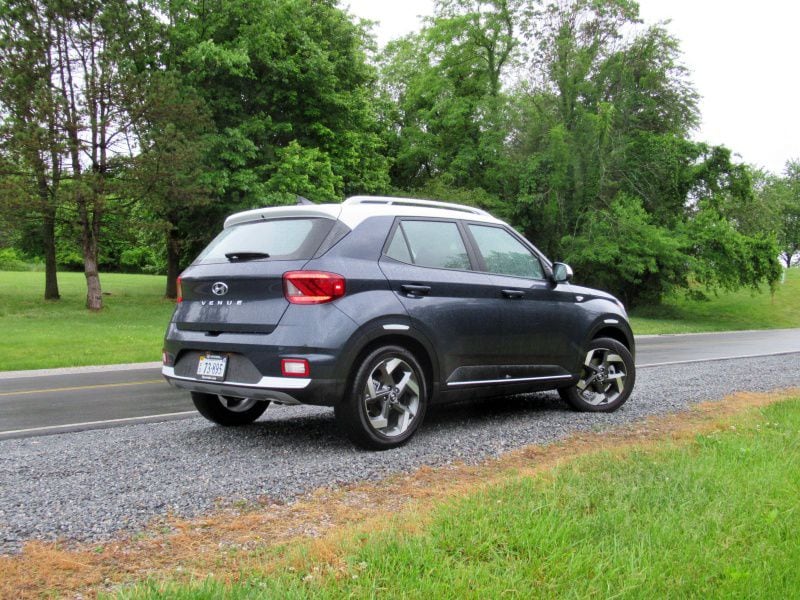
Photo by Brady Holt
Final Thoughts
The 2021 Hyundai Venue is an excellent city car. It’s inexpensive and easy to drive around town. Its tiny footprint and extra-tight turning radius are perfect for crowded cities. It gets phenomenal real-world gas mileage, has a long warranty and free scheduled maintenance, and it has useful cargo space if you fold the rear seat down.
Still, the Kicks is a bigger vehicle at a similar price, and that’s a fairly compelling combination. The Nissan lets you fit adults in the backseat, it’s more comfortable on the highway, it has more safety features, and it gets better EPA-estimated fuel economy. Even though it’s bigger than the Venue, it’s still smaller than nearly any other SUV you can buy. And its surround-view parking camera is particularly handy for parallel parking or squeezing between dumpsters in a crowded alley. The Venue looks and feels more modern than the Kicks to us, and its smaller size will be an advantage rather than a liability for some drivers. But especially after this year’s fresh improvements, the Nissan is the more well-rounded option.
Nissan Kicks
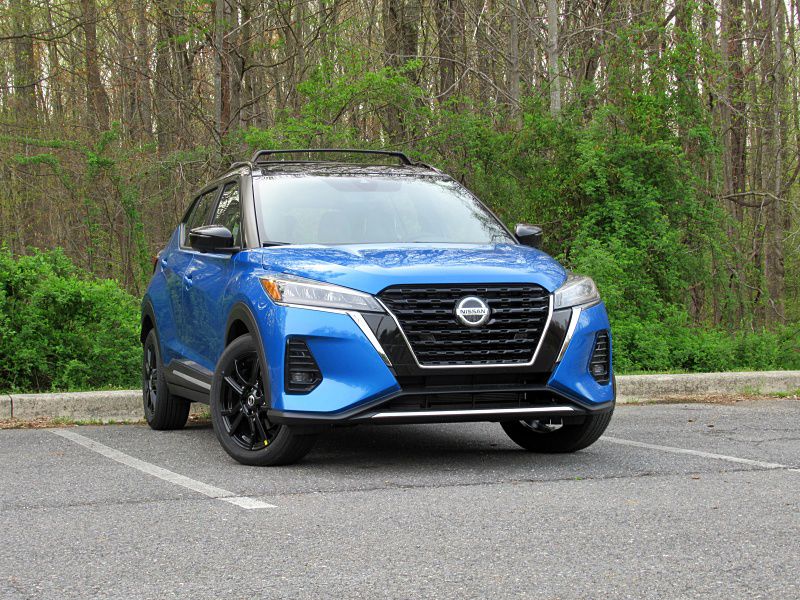
Photo by Brady Holt